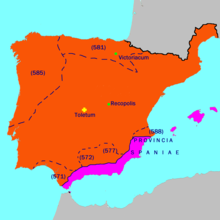Reccopolis
Reccopolis (Spanish Recópolis ) was a late antique-early medieval city of the Visigoth Empire in Spain. It was located on the Cerro de la Oliva ("olive tree hill") near the present-day village of Zorita de los Canes in the province of Guadalajara in central Spain, east of Madrid. The name of the region at that time was Celtiberia.
history
Reccopolis was founded by the Visigoth king Leovigild (r. 569-586) in 578. This step belongs in the context of Leovigild's “imperialization” of the Visigoth kingship through the demonstrative exercise of traditional privileges of the Roman and Eastern Roman emperors . The foundation of cities was not common in the Germanic empires of the early Middle Ages and otherwise unknown to the Visigoths before Leovigild. Assumptions that Reccopolis was conceived as the new imperial capital are speculative. There was a mint there that was still active under King Witiza (r. 702–710), but Reccopolis was never a bishopric and the city is never mentioned in the surviving Visigoth documents. Apart from the mention by Johannes Biclarensis, the existence of the city is only attested by coins with its name and by the archaeological evidence.
Surname
The contemporary chronicler John of Biclaro reported that Leovigild the city after his younger son and eventual successor I. Reccared named. Rekkared was nominally co-ruler of Leovigild, like his older brother Hermenegild , since 573 . The naming of the city after him, while the older brother apparently did not receive a comparable honor, is a sign of a conspicuous preference for Rekkared as early as 578. The following year there was a break between Hermenegild and Leovigild when Hermenegild began an uprising against his father whereby he forfeited the position of heir to the throne . From then on, this came exclusively to Rekkared.
Recently, another etymology of the city name has been considered, namely not "City of Rekkareds", but derivation from rex (king), ie "royal city". The reason for this is that if it is named after Rekkared, the name must be "Reccaredopolis"; there is no precedent for cutting from Reccaredo- to Recco- . However, the derivation of rex is linguistically at least as problematic as the other solution, and it contradicts the express statement of the contemporary Johannes von Biclaro.
City layout
The floor plan shows a spacious complex (about 33 hectares) with a large, richly decorated church and a monumental building that can be interpreted as the palace of the royal family. Possibly it was a residence intended for temporary use or a later added mosque , because the settlement was still inhabited in the Islamic period, but fell into disrepair in the 8th and 9th centuries.
The site was already known at the end of the 19th century, but the excavations did not begin until 1944/45. So far, only a small part has been conclusively researched; Further information can be expected from future excavations. Today the area is called Parque Arqueológico de Recópolis.
literature
- Javier Arce: The So-Called visigothic “Palatium” of Recópolis (Spain). An Archaeological and Historical Analysis . In: Michael Featherstone, Jean-Michel Spieser et al. (Eds.): The Emperor's House. Palaces from Augustus to the Age of Absolutism (= Urban Spaces ). tape 4 . de Gruyter, Berlin et al. 2015, ISBN 978-3-11-033163-9 , p. 63-70 .
- Gisela Ripoll: Reccopolis. In: Reallexikon der Germanischen Altertumskunde (RGA). 2nd Edition. Volume 24, Walter de Gruyter, Berlin / New York 2003, ISBN 3-11-017575-4 , pp. 204-208.
- Matthias Untermann : Architecture in the early Middle Ages . Wissenschaftliche Buchgesellschaft, Darmstadt 2006. ISBN 978-3-534-03122-1 , pp. 33f.
- J. Martínez Jiménez: A preliminary study of the aqueduct of Reccopolis. Oxford Journal of Archeology 343 (3) 1950, pp. 301-320.
Web links
Remarks
- ↑ Johannes von Biclaro, Chronica 50th edition: Carmen Cardelle de Hartmann, Roger Collins (ed.): Victoris Tunnunensis Chronicon cum reliquiis ex Consularibus Caesaraugustanis et Iohannis Biclarensis Chronicon (= Corpus Christianorum. Series Latina. Volume 173A). Brepols, Turnhout 2001, ISBN 2-503-01734-7 , p. 70.
- ^ Roger Collins: Visigothic Spain 409-711. Blackwell, Malden (MA) et al. 2004, ISBN 0-631-18185-7 , pp. 55 f.
- ↑ Reccopolis - mosque (?)
Coordinates: 40 ° 19 ′ N , 2 ° 54 ′ W


